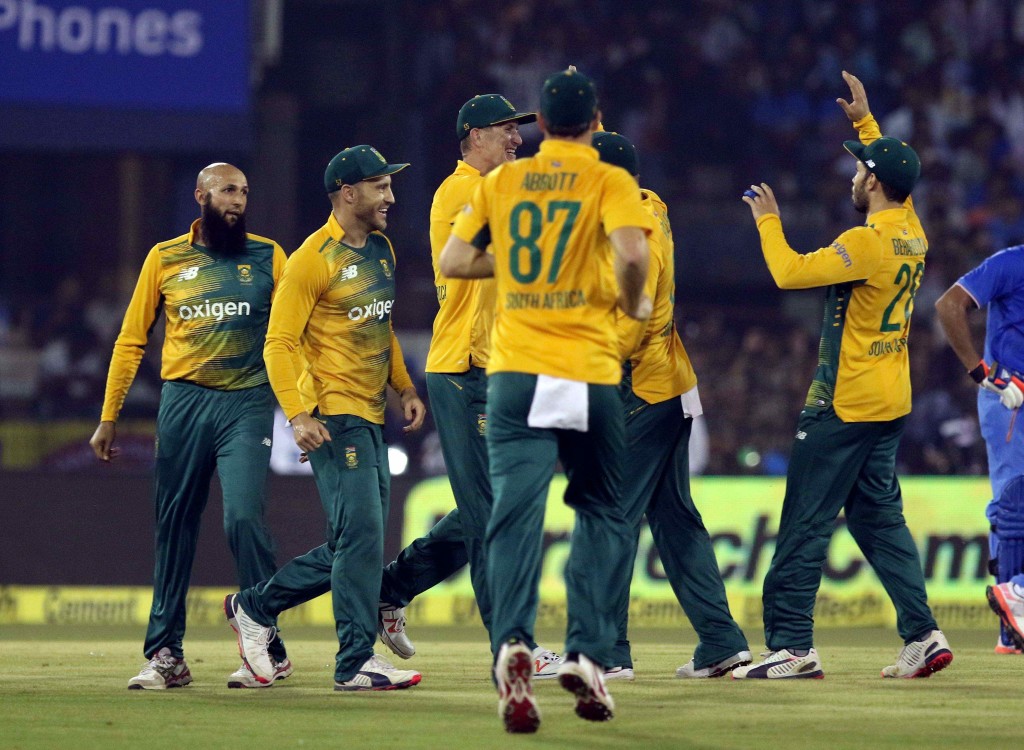South Africa have been impressive all round in winning the T20I series against India. It’s been a powerful statement.
Captain Faf du Plessis chose to focus on an ‘amazing performance by the bowlers’ in the second T20, in which the hosts were bowled out for 92 with 17 balls remaining in their innings. Not taking anything away from the bowlers, they were helped by inept Indian batting.
In the second T20I, Shikhar Dhawan missed a ball from Chris Morris and was adjudged lbw, Ambati Rayudu missed a straight full toss and was bowled by Kagiso Rabada, MS Dhoni slashed at a wide one from Albie Morkel and was caught behind and Axar Patel completely misread a length ball on middle stump from Morkel, while the last two wickets to fall were also full and straight – balls that you’d have expected India’s batsmen to easily negotiate on another day.
However, the pressure that came from the early wickets, innovative bowling changes and variety of the attack, led to India losing their heads. Well done to captain Du Plessis and the Proteas bowlers who backed up his decision-making with wickets.
Overall, from the two winning matches – both with the batsmen confronted by two very different chases, one of 200 and the other of 93 – there were two other aspects that impressed.
The one is the ‘experiment’ of AB de Villiers opening the batting. That simply has to continue from here on forward. De Villiers is the best batsman in the side and must be given the most number of overs to be able to get himself ‘in’ and then destroy the opposition bowlers. In the opening T20I, chasing 200, he batted until 9.5 overs of the innings, had hit 51 off 31 balls and departed with the score on 93, and as such had set up the big chase perfectly.
In the second T20I, it was a different innings, but when he was out off the last ball of the eighth over, the Proteas were on 49, halfway to the small target, but with plenty of overs remaining. Again, the pacing of his innings was perfect, showing a real cricketing brain under that helmet.
Also, it’s worth noting the success of the opening three batsmen with him and Hashim Amla opening and Du Plessis in at three.
In the first T20I, India reached 46-1 in their six-over powerplay. South Africa responded with 67-0 in theirs. The tone was set for a successful chase.
In the second T20I, India reached 35-2 in those opening six overs. South Africa responded with 38-2, again showing the cool heads behind the chase, always ahead of the run rate and therefore not being exposed to that scoreboard pressure.
The other theme worth dwelling on has been the improved display in the Proteas fielding. In both matches so far, India have suffered four run outs. Ironically, a misfield from Morris led to Dhakwan’s demise in the first match, running on a misfield but then beaten by the accurate throw to the wicketkeeper. Then Rayudu chose to take on the arm of Amla at square leg and was beaten by the throw to the bowler.
In the second encounter, Virat Kohli chose to take on the arm of Morris in the deep and the fielder did well to make ground, collect and fire in on the bounce for De Villiers to finish off behind the stumps. Rohit Sharma then also hit the ball straight to a fielder, in this case David Miller, and set off for a run from deep in his own crease. A direct hit from the powerful arm of Miller and the dangerous Sharma simply kept on running to the dugout.
This series win has been a real team effort, bowlers combining with good fielding and accurate throwing – something that’s been missing for a while from the Proteas, especially in the ODI format – but don’t ignore the significance of De Villiers opening the batting either.







